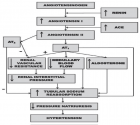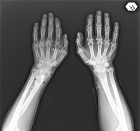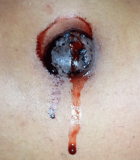Abstract
Research Article
Emergency care sick palliative and problems oncology in emergency department during the COVID-19 pandemic
Basri Lenjani*, Premtim Rashiti, Gani Shabani, Nehat Baftiu*, Blerim Krasniqi, Arber Demiri, Besarta Pelaj, Arban Demi and Dardan Lenjani
Published: 30 September, 2020 | Volume 4 - Issue 1 | Pages: 024-027
Emergency medical care in palliative patients during the COVID-19 pandemic, it is important to provide a consistent treatment for stable patients that should be consistent with the goals and benefits, the perspective of these patients, but avoiding palliative patients with a poor prognosis that is unlikely to survive. Cancer is the second leading cause of death in the world around 8.8 million deaths a year. Worldwide, about 7-10 million patients are diagnosed with cancer each year, recently there has been a significant increase in the number of cases diagnosed with cancer. About 70% of cancer deaths are in low- and middle-income countries. The goals of emergency medical care based on the criteria of BLS and ACLS, that is should be done “Do not do resuscitation, do not intubate but continue medical treatment excluding endotracheal intubation without prospects for the patient, but offering BLS only treatment concentrated symptomatic. ED is often the only place that can provide the necessary medical interventions (e.g., intravenous fluids or pain management medications. Medications as well as immediate access to advanced diagnostic tests when needed such as CT, RM and other diagnostic and treatment procedures.
Read Full Article HTML DOI: 10.29328/journal.apcr.1001019 Cite this Article Read Full Article PDF
Keywords:
Palia1tive care; Emergency; Department; Resuscitation; Medical support; Medical treatment; Education and training
References
- Ahmad A, Mueller C, Tsamakis K. Covid-19 pandemic: A public and global mental health opportunity for social transformation? BMJ. 2020; 369: m1383. PubMed: https://pubmed.ncbi.nlm.nih.gov/32253252/
- Block BL, Jeon SY, Sudore RL, Matthay MA, Boscardin WJ, et al. Patterns and trends in advance care planning among older adults who received intensive care at the end of life. JAMA Intern Med. 2020; 180: 786-789. PubMed: https://pubmed.ncbi.nlm.nih.gov/32119031/
- CDC COVID-19 Response Team. COVID-19 response team. preliminary estimates of the prevalence of selected underlying health conditions among patients with Wu Z, McGoogan JM. Characteristics of and important lessons from the coronavirus disease (COVID-19) outbreak in China: summary of a report of 72 314 cases from the Chinese Center for Disease Control and Prevention. JAMA. 2020.
- Coronavirus Disease 2019-United States, February 12-March 28, 2020. MMWR Morb Mortal Wkly Rep. 2020; 69: 381-384.
- Curtis JR, Kross EK, Stapleton RD. The importance of addressing advance care planning and decisions about do-not- resuscitate orders during novel Coronavirus (COVID- 19). JAMA. 2020; 323: 1771-1772. PubMed: https://pubmed.ncbi.nlm.nih.gov/32219360/
- Docea AO, Tsatsakis A, Albulescu D, Cristea O, Zlatian O, et al. A new threat from an old enemy: Re-emergence of coronavirus (Review) Int J Mol Med. 2020; 45: 1631–1643. PubMed: https://www.ncbi.nlm.nih.gov/pmc/articles/PMC7169834/
- Lu E, Nakagawa S. Three-stage protocol for serious illness conversations: reframing communication in real time. Mayo Clin Proc. 2020; 95: 1589-1593. PubMed: https://pubmed.ncbi.nlm.nih.gov/32278484/
- Onder G, Rezza G, Brusaferro S. Case-fatality rate and characteristics of patients dying in relation to COVID-19 in Italy. JAMA. 2020; 23: 1775-1776. PubMed: https://pubmed.ncbi.nlm.nih.gov/32203977/
- Tsamakis K, Rizos E, Manolis JA, Chaidou S, Kympouropoulos S, et al. [Comment] COVID-19 pandemic and its impact on mental health of healthcare professionals. Exp Ther Med. 2020; 19: 3451–3453. PubMed: https://pubmed.ncbi.nlm.nih.gov/32346406/
Similar Articles
-
Pregnancy and childbirth in women aged 40 and over at befelatanana maternity, MadagascarRakotomalala Nivoarimelina Zoly1*,Rakotozanany Besaina3,,Razafi ndraibe Andriatompoina Felanarivo3,, Ramarokoto Malalafi naritra Patrick Marco1,2,Rafamatanantsoa Jean Florent,Kapche Wato Edith,d Randriambololona Domoina Malala Aurélia5. Pregnancy and childbirth in women aged 40 and over at befelatanana maternity, Madagascar. . 2019 doi: 10.29328/journal.apcr.1001015; 3: 022-027
-
Molecular analysis of immunoglobulins related to Salmonella typhi in pediatric patientsFarah Qudsia, Muhammad Rehan,Samreen Riaz*. Molecular analysis of immunoglobulins related to Salmonella typhi in pediatric patients. . 2020 doi: 10.29328/journal.apcr.1001017; 4: 005-010
-
Emergency care sick palliative and problems oncology in emergency department during the COVID-19 pandemicBasri Lenjani*,Premtim Rashiti,Gani Shabani,Nehat Baftiu*, Blerim Krasniqi, Arber Demiri,Besarta Pelaj,Arban Demi,Dardan Lenjani. Emergency care sick palliative and problems oncology in emergency department during the COVID-19 pandemic. . 2020 doi: 10.29328/journal.apcr.1001019; 4: 024-027
-
The Accuracy of pHH3 in Meningioma Grading: A Single Institution StudyMansouri Nada1, Yaiche Rahma*, Takout Khouloud, Gargouri Faten, Tlili Karima, Rachdi Mohamed Amine, Ammar Hichem, Yedeas Dahmani, Radhouane Khaled, Chkili Ridha, Msakni Issam, Laabidi Besma. The Accuracy of pHH3 in Meningioma Grading: A Single Institution Study. . 2024 doi: 10.29328/journal.apcr.1001041; 8: 006-011
-
Clinical and Histopathological Mismatch: A Case Report of Acral FibromyxomaMonica Mishra*,Kailas Mulsange,Gunvanti Rathod,Deepthi Konda. Clinical and Histopathological Mismatch: A Case Report of Acral Fibromyxoma. . 2025 doi: 10.29328/journal.apcr.1001045; 9: 005-007
Recently Viewed
-
The efficacy of complex Decongestive Physiotherapy in patients with Bilateral Primary Lower Extremity Lymphedema and Untreatable multiple health conditions: A Case ReportHümeyra Kiloatar PT*. The efficacy of complex Decongestive Physiotherapy in patients with Bilateral Primary Lower Extremity Lymphedema and Untreatable multiple health conditions: A Case Report. J Nov Physiother Rehabil. 2017: doi: 10.29328/journal.jnpr.1001011; 1: 093-098
-
Cystoid Macular Oedema Secondary to Bimatoprost in a Patient with Primary Open Angle GlaucomaKonstantinos Kyratzoglou*,Katie Morton. Cystoid Macular Oedema Secondary to Bimatoprost in a Patient with Primary Open Angle Glaucoma. Int J Clin Exp Ophthalmol. 2025: doi: 10.29328/journal.ijceo.1001059; 9: 001-003
-
Metastatic Brain Melanoma: A Rare Case with Review of LiteratureNeha Singh,Gaurav Raj,Akshay Kumar,Deepak Kumar Singh,Shivansh Dixit,Kaustubh Gupta*. Metastatic Brain Melanoma: A Rare Case with Review of Literature. J Radiol Oncol. 2025: doi: ; 9: 050-053
-
Depression as a civilization-deformed adaptation and defence mechanismBohdan Wasilewski*,Olha Yourtsenyuk,Eugene Egan. Depression as a civilization-deformed adaptation and defence mechanism. Insights Depress Anxiety. 2020: doi: 10.29328/journal.ida.1001013; 4: 008-011
-
Drinking-water Quality Assessment in Selective Schools from the Mount LebanonWalaa Diab, Mona Farhat, Marwa Rammal, Chaden Moussa Haidar*, Ali Yaacoub, Alaa Hamzeh. Drinking-water Quality Assessment in Selective Schools from the Mount Lebanon. Ann Civil Environ Eng. 2024: doi: 10.29328/journal.acee.1001061; 8: 018-024
Most Viewed
-
Evaluation of Biostimulants Based on Recovered Protein Hydrolysates from Animal By-products as Plant Growth EnhancersH Pérez-Aguilar*, M Lacruz-Asaro, F Arán-Ais. Evaluation of Biostimulants Based on Recovered Protein Hydrolysates from Animal By-products as Plant Growth Enhancers. J Plant Sci Phytopathol. 2023 doi: 10.29328/journal.jpsp.1001104; 7: 042-047
-
Sinonasal Myxoma Extending into the Orbit in a 4-Year Old: A Case PresentationJulian A Purrinos*, Ramzi Younis. Sinonasal Myxoma Extending into the Orbit in a 4-Year Old: A Case Presentation. Arch Case Rep. 2024 doi: 10.29328/journal.acr.1001099; 8: 075-077
-
Feasibility study of magnetic sensing for detecting single-neuron action potentialsDenis Tonini,Kai Wu,Renata Saha,Jian-Ping Wang*. Feasibility study of magnetic sensing for detecting single-neuron action potentials. Ann Biomed Sci Eng. 2022 doi: 10.29328/journal.abse.1001018; 6: 019-029
-
Pediatric Dysgerminoma: Unveiling a Rare Ovarian TumorFaten Limaiem*, Khalil Saffar, Ahmed Halouani. Pediatric Dysgerminoma: Unveiling a Rare Ovarian Tumor. Arch Case Rep. 2024 doi: 10.29328/journal.acr.1001087; 8: 010-013
-
Physical activity can change the physiological and psychological circumstances during COVID-19 pandemic: A narrative reviewKhashayar Maroufi*. Physical activity can change the physiological and psychological circumstances during COVID-19 pandemic: A narrative review. J Sports Med Ther. 2021 doi: 10.29328/journal.jsmt.1001051; 6: 001-007

HSPI: We're glad you're here. Please click "create a new Query" if you are a new visitor to our website and need further information from us.
If you are already a member of our network and need to keep track of any developments regarding a question you have already submitted, click "take me to my Query."


















































































































































